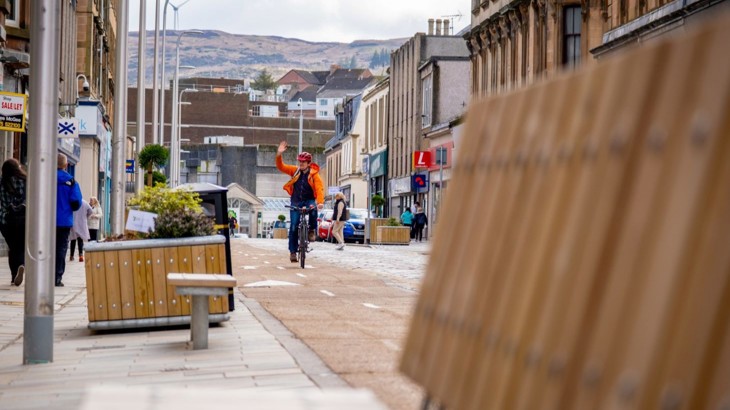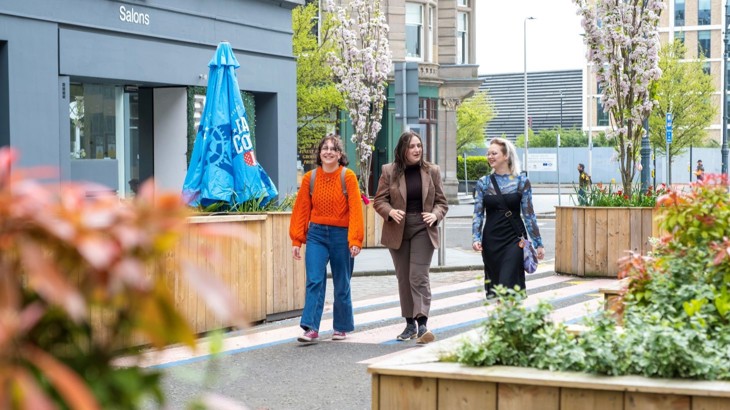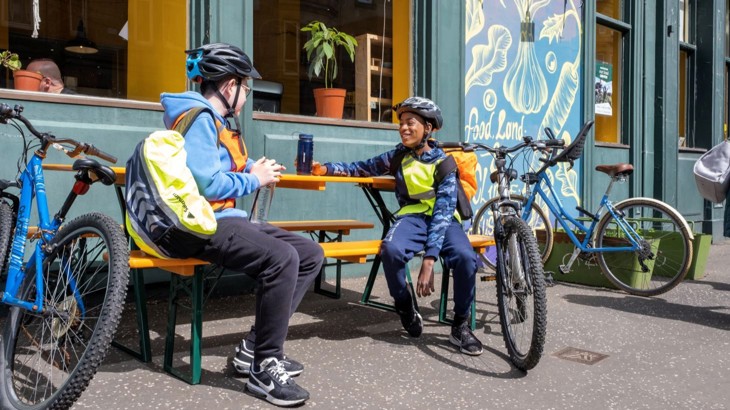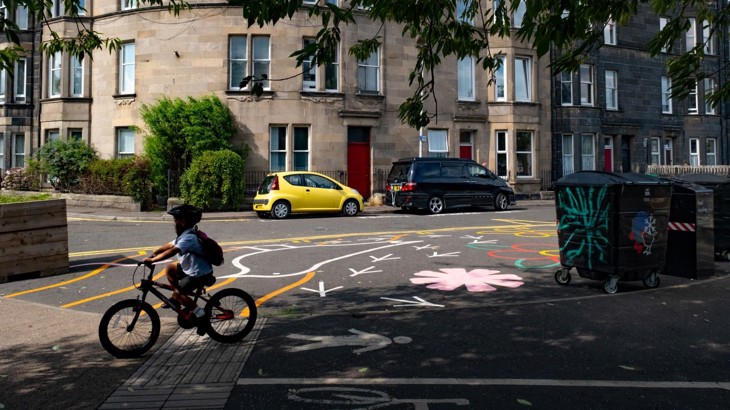Our latest research looks at how active travel could help facilitate Community Wealth Building – an approach that emphasises the ‘local’ in local economy.

Greenock's transformed high street is more attractive to residents, visitors and businesses. Credit: Michael Kelly.
What is Community Wealth Building?
Imagine a world where local supports local: where councils, schools and hospitals buy their goods and services from local businesses.
This is Community Wealth Building in action.
Community Wealth Building is about ensuring that wealth generated in local communities stays there.
This means money is reinvested in the community, helping to tackle inequalities and reduce demand on public services in a just and fair way.
In recent years, the Scottish Government has started to adopt this approach, with a proposed bill now looking to embed Community Wealth Building across communities in Scotland.
Our latest research looks at how active travel could help facilitate Community Wealth Building.
Where does active travel come in?
Active travel not only has a positive impact on our physical and mental health – it's about transforming how we live and work.
Evidence shows that active travel contributes positively to the local economy.
Better walking, wheeling and cycling infrastructure encourages people to shop locally, keeping wealth circulating in the community.
Cycle-friendly roads and accessible, welcoming footpaths help create thriving local high streets and bustling town centres.
In doing so, active travel helps strengthen communities – as does Community Wealth Building.
Sustrans' Research and Monitoring Unit (RMU) therefore set out to investigate how active travel could contribute to this approach.

Dundee's Union Street is an attractive space for people to spend time in and visit local businesses. Credit: McAteer.
What did the research involve?
We looked at organisations where Community Wealth Building was already working and reviewed best practices from Scotland and beyond.
Our Research and Monitoring Unit spoke with council employees who have helped set up the approach, as well as subject matter experts from wider organisations.
In North Ayrshire, Community Wealth Building has been a key part of the council’s economic strategy, making it an insightful case study to focus on.
North Ayrshire Council has created a commission of representatives from large local organisations to drive Community Wealth Building and work to shared goals.
The approach has been embedded through policy in a variety of areas, resulting in measures such as the creation of a Repurposing Property Grant Fund Initiative.
This fund enables small areas of land or property to be repurposed for local community benefit.
We also reviewed examples and best practice of walking, wheeling and cycling contributing to Community Wealth Building aims, and discussed this with experts.
From this research we created a framework for considering active travel within Community Wealth Building.
For example, integrating active travel into regeneration projects in North Ayrshire could create jobs, whilst cutting carbon emissions and improving public health.

Glasgow's South City Way takes people directly to the doorsteps of local cafes and shops. Credit: McAteer.
What are the challenges we identified?
Our research identified that planning and investment often neglects walking, wheeling and cycling infrastructure.
Active travel is treated as an afterthought, rather than a cornerstone of economic and social strategy.
On the back of this, our report proposes a set of approaches to unleash the potential of active travel for local businesses and communities.
- Community Input: Local voices matter. Let’s involve communities in designing travel networks that truly serve their needs.
- Big-Picture Thinking: Anchor institutions - like councils and schools - can lead by example, adopting sustainable transport and procurement practices.
- Infrastructure First: Let’s make active travel a priority in every regeneration and development plan.

Reallocated space in Leith is helping reduce emissions, and improve safety and public health. Credit: Michael Kelly.
Why should this be a priority?
It is hard to keep up with the pace of change, particularly when it comes to our climate.
We know that economic resilience and sustainability are no longer optional, but essential.
Our report shows that active travel and Community Wealth Building together offer a clear path forward in making our towns and cities better places to live and work – now and into the future.
As Community Wealth Building develops across Scotland, we hope these findings support professionals to consider how active travel can contribute to schemes.
This will help local areas to flourish and be more resilient, healthy, and self-reliant.






